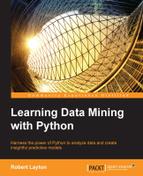In this chapter, we looked at the text mining-based problem of authorship attribution. To perform this, we analyzed two types of features: function words and character n-grams. For function words, we were able to use the bag-of-words model—simply restricted to a set of words we chose beforehand. This gave us the frequencies of only those words. For character n-grams, we used a very similar workflow using the same class. However, we changed the analyzer to look at characters and not words. In addition, we used n-grams that are sequences of n tokens in a row—in our case characters. Word n-grams are also worth testing in some applications, as they can provide a cheap way to get the context of how a word is used.
For classification, we used SVMs that optimize a line of separation between the classes based on the idea of finding the maximum margin. Anything above the line is one class and anything below the line is another class. As with the other classification tasks we have considered, we have a set of samples (in this case, our documents).
We then used a very messy dataset, the Enron e-mails. This dataset contains lots of artefacts and other issues. This resulted in a lower accuracy than the books dataset, which was much cleaner. However, we were able to choose the correct author more than half the time, out of 10 possible authors.
In the next chapter, we consider what we can do if we don't have target classes. This is called unsupervised learning, an exploratory problem rather than a prediction problem. We also continue to deal with messy text-based datasets.
